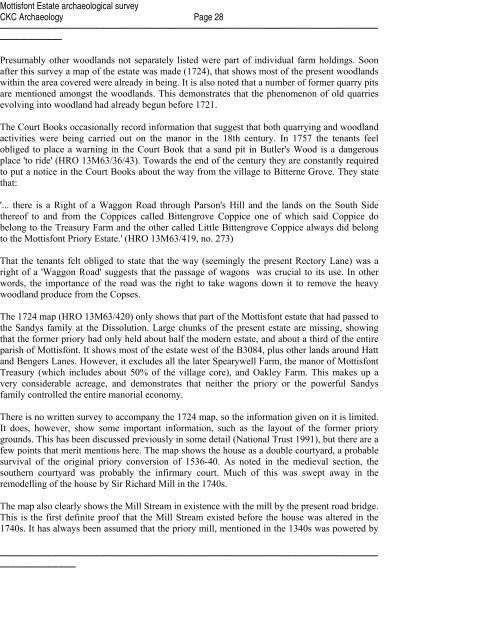An archaeological and historical - Archaeology Data Service
An archaeological and historical - Archaeology Data Service
An archaeological and historical - Archaeology Data Service
Create successful ePaper yourself
Turn your PDF publications into a flip-book with our unique Google optimized e-Paper software.
Mottisfont Estate <strong>archaeological</strong> survey<br />
CKC <strong>Archaeology</strong> Page 28<br />
───────────────────────────────────────────────────────<br />
─────────<br />
Presumably other woodl<strong>and</strong>s not separately listed were part of individual farm holdings. Soon<br />
after this survey a map of the estate was made (1724), that shows most of the present woodl<strong>and</strong>s<br />
within the area covered were already in being. It is also noted that a number of former quarry pits<br />
are mentioned amongst the woodl<strong>and</strong>s. This demonstrates that the phenomenon of old quarries<br />
evolving into woodl<strong>and</strong> had already begun before 1721.<br />
The Court Books occasionally record information that suggest that both quarrying <strong>and</strong> woodl<strong>and</strong><br />
activities were being carried out on the manor in the 18th century. In 1757 the tenants feel<br />
obliged to place a warning in the Court Book that a s<strong>and</strong> pit in Butler's Wood is a dangerous<br />
place 'to ride' (HRO 13M63/36/43). Towards the end of the century they are constantly required<br />
to put a notice in the Court Books about the way from the village to Bitterne Grove. They state<br />
that:<br />
'... there is a Right of a Waggon Road through Parson's Hill <strong>and</strong> the l<strong>and</strong>s on the South Side<br />
hereof to <strong>and</strong> from the Coppices called Bittengrove Coppice one of which said Coppice do<br />
belong to the Treasury Farm <strong>and</strong> the other called Little Bittengrove Coppice always did belong<br />
to the Mottisfont Priory Estate.' (HRO 13M63/419, no. 273)<br />
That the tenants felt obliged to state that the way (seemingly the present Rectory Lane) was a<br />
right of a 'Waggon Road' suggests that the passage of wagons was crucial to its use. In other<br />
words, the importance of the road was the right to take wagons down it to remove the heavy<br />
woodl<strong>and</strong> produce from the Copses.<br />
The 1724 map (HRO 13M63/420) only shows that part of the Mottisfont estate that had passed to<br />
the S<strong>and</strong>ys family at the Dissolution. Large chunks of the present estate are missing, showing<br />
that the former priory had only held about half the modern estate, <strong>and</strong> about a third of the entire<br />
parish of Mottisfont. It shows most of the estate west of the B3084, plus other l<strong>and</strong>s around Hatt<br />
nd Bengers Lanes. However, it excludes all the later Spearywell Farm, the manor of Mottisfont<br />
reasury (which includes about 50% of the village core), <strong>and</strong> Oakley Farm. This makes up a<br />
ery considerable acreage, <strong>and</strong> demonstrates that neither the priory or the powerful S<strong>and</strong>ys<br />
amily controlled the entire manorial economy.<br />
here is no written survey to accompany the 1724 map, so the information given on it is limited.<br />
t does, however, show some important information, such as the layout of the former priory<br />
rounds. This has been discussed previously in some detail (National Trust 1991), but there are a<br />
ew points that merit mentions here. The map shows the house as a double courtyard, a probable<br />
urvival of the original priory conversion of 1536-40. As noted in the medieval section, the<br />
outhern courtyard was probably the infirmary court. Much of this was swept away in the<br />
emodelling of the house by Sir Richard Mill in the 1740s.<br />
he map also clearly shows the Mill Stream in existence with the mill by the present road bridge.<br />
his is the first definite proof that the Mill Stream existed before the house was altered in the<br />
740s. It has always been assumed that the priory mill, mentioned in the 1340s was powered by<br />
───────────────────────────────────────────────────────<br />
───────────

















